|
2005
HOSPICE DU RHÔNE - PASO ROBLES, CA -
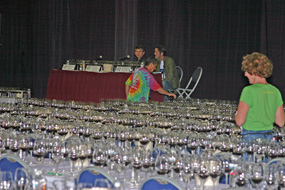 |
|
Sommeliers
wade through a sea of glasses
|
Held
Friday & Saturday, May 13 & 14, 2005,
the 13th annual Hospice
du Rhône drew Rhône wine producers and
enthusiasts from around the world to see, hear and taste
what is new (and old, for that matter) in Syrah,
Grenache, and twenty other Rhône varietals. This
two-day event features wine seminars that include vertical
tastings, two very large Library and Grand tastings,
and the unique opportunity to meet and talk with the
producers and winemakers who are at the forefront of
the burgeoning Rhône varietal movement throughout
the world. Seminar presenters, wineries and attendees
come from all over the U.S., France, Australia, South
Africa and several other countries to attend this annual
festival.
The
seminars are included in the "complete weekend
package;" tickets are not available to attend the
individual presentations. The HdR seminars are always
a cut above any others, because they are moderated and
paneled by established growers, producers and winemakers
- each of them industry legends. Were that not enough,
the wines assembled for each seminar are matched to
the seminar theme, and are frequently assembled from
the remaining stocks or libraries of the presenters.
Funny
Business
Despite
the instructive nature of these seminars, they never
border on stiff or boring. In fact, there are always
one or more surprises - often gags played on or by presenters,
or the HdR organizers themselves. This year was no exception.
John Alban started off the festivities with a welcome
and introduction of this year's seminar program. Noting
that it took "big balls" to start an HdR on
Friday the 13th, John rhetorically asked Executive Director
Vicki Carroll, "...speaking of 'big balls,' where's
Mat?" Vicki played along, shrugging that she didn't
know. At that moment, Mat appeared at the back of the
hall, dressed as Dorothy from the 'Wizard of Oz,' (this
year's theme 'there's no place like Rhône') and
proceeded to skip up to the front of the room to join
John and Vicki. Standing there in a gingham size 22
dress and pig-tailed wig, Mat asks in a surprised tone,
"you didn't get the memo?" John replies deadpanned,
"no, obviously, you didn't get the memo."
(Mat was to recount later that a size-22 was the biggest
dress they could find, and the sleeves still had to
be cut to get his arms into them. "My arms were
turning blue - I told them 'cut me, cut me.'")
Later,
after the end of the second seminar, Mat continued with
his annual 'drink pink' mantra - his own personal campaign
for Rose wines. With their rendition of 'Pink Gun,'
Mat and his troup parodied the movie 'Top Gun,' in a
nearly-professional video that ran about 15 minutes
after the second seminar. Needless to say, Mat's wife
Amie played the Kelly McGillis role.
Alvaro
Time
Another
stunt took place just before the last seminar.
John Alban introduced the panel and began to
describe the lengths to which he had to go to get Alvaro
Palacios to come to HdR. John had apparently been calling
the Bodega frequently, asking to speak to Alvaro. The
answer from his assistant, Blanca, always seemed to
be the same - thank you, but Señor Palacios doesn't
like to speak to large crowds.
However,
never wanting to miss an opportunity to call (although
he was afraid he was starting to look like a stalker),
John glanced at his watch one night, while he, Mat and
Vicki were out on the road. Considering the time zones,
John announced, "Hey, it's 1:00 in the morning
here - it must be Alvaro time," and started dialing
the phone. "Hi Blanca, is Alvaro there," he
asked for what was probably the upteenth time. Let me
see if he'll speak to you, she said. Blanca then came
back to the phone to tell John that "he'll speak
to you next year about attending." Wow," said
John jumping up and down and turning to tell Mat and
Vicki the good news - "Alvaro's coming next year,
Alvaro's coming next year." Over-hearing this,
Blanca corrected John, "no, no, he'll talk
to you next year about coming some time in the future."
Long
story short, Alvaro Palacios decided to come to HdR
in 2005. There was just one hitch - Palacios was not
used to speaking in front of a "crowd." Well,
it's not really a 'crowd,' it's more of a mob, John
recalled thinking to himself. But, John decided he needed
to set his guest at ease when he arrived for the seminar.
So, at the start of the seminar, Alban reminded all
of us of the old axiom about how speakers should imagine
the audience in their underwear. "So, Alvaro,"
he said, addressing Palacios, "I'll start first."
John then proceeded to strip down to his underwear,
a pair of "Bazooka" bubble gum boxers! Were
it not enough to witness John Alban standing there with
pants to his knees, a band of "extras" then
came marching out in their underwear, turning
around to reveal that their backsides spelled out "WE
[HEART] ALVARO." Now there's an opening
you won't see at your average stuffy wine festival.
|
|
The
Wines of Kilikanoon and Pike - Friday, 10:00AM
|
| PIKES
:
1998
Pikes Shiraz - Clare Valley. Has a light cedar
infusion to the dark fruit nose. Rich mouthfeel,
with lots of spice and a nice smooth finish.
2004
Pikes "Gills Farm" Viognier - Clare
Valley. Lightly floral scent, with notes of
white peach and jasmine. Crisp mouthfeel, light
peach/apricot flavor with a honeysuckle taste
to the long finish.
2002
Pikes Shiraz Mourvedre Grenache - Clare Valley.
Rich, lightly spiced chocolate/vanilla scent to
the nose. Fleshy and slightly sweet mouthfeel,
with lingering spices on the palate. (French oak
only. Neil attributed the chocolate to the Grenache.)
2002
Pikes Shiraz - Clare Valley. Deeper, and more
brooding in the nose, with lots of spice and pepper
and a hint of chocolate mint. Full and rich on
the palate, Neil said that while he didn't try
for a big wine intentionally, the excellent vintage
was delivered by perfect weather.
2003
Pikes "EWP" Shiraz - Clare Valley.
Light minty spices in the blackberry nose. More
refined on the palate than some of the preceding
wines, the spiciness still came through in the
flavor profile, and lingered through the long
very smooth dark berry finish.
KILIKANOON
:
2002
Kilikanoon "Killermans Run" Shiraz Grenache
- Clare Valley. Nose of dark cherry and blackberry,
with hints of cedar, mint and a touch of spice.
Much more Grenache-like in mouthfeel, with lots
of raspberry and sweet/sour dark cherry.
2002
Kilikanoon "Medley" GSM - Clare Valley.
Very similar to the Killermans Run, the nose seems
darker in fruit that the mouthfeel. Still plenty
of spice throughout, with a light chocolate tinge
on the finish.
2002
Kilikanoon "Prodigal" Grenache - Clare
Valley. Lots of raspberry, spice, and a dollop
of chocolate in the nose. Initially sweet mouthfeel,
that gets more sweet/sour toward mid-palate, leading
to a long spicy finish.
2002
Kilikanoon "Parable" Shiraz - Clare
Valley. Somewhat closed in the nose, with
background notes of black raspberry and spice.
Full in mouthfeel, lots of dark fruit, somewhat
chewy textures and long finish.
2002
Kilikanoon "Covenant" Shiraz - Clare
Valley. Wow! Big and bold aromas of dark fruit,
with lesser notes of roasted nuts and cake spices.
Very smooth and tasty on the palate, lots of fine-grained
tannins, smooth luxurious finish.
2001
Kilikanoon "Oracle" Shiraz - Clare Valley.
Right now, this bottling is somewhere between
the Parable and the Covenant in terms of size
and structure. Beautiful spiced dark fruit nose,
and lots of tasty fruit on the palate, and nicely
balanced finish.
2002
Kilikanoon "Oracle" Shiraz - Clare Valley.
Gorgeous nose of blackberry pie, big rich mouthfeel
with masses of fruit on the palate, and very long
tasty finish.
2002
Kilikanoon Barossa Reserve Shiraz - Clare Valley.
Fabulous nose of blackberry, mint, toasted bread,
and spices. Very concentrated mouthfeel, with
wonderful balance and long seamless finish.
|
(Moderated
by Peter Kasperski of Cowboy Ciao, this seminar gave
us a look at the wines from the Kevin Mitchell of Kilikanoon
and Neil Pike of Pike's Wines.)
|

|
|
(l to r) Kevin Mitchell, Neil Pike, and moderator
Peter Kasperski
|
Moderator
Peter Kasperski (owner of several restaurants and wine
bars in Arizona) began by telling us of his own admiration
for Clare Valley, and then introduced Kevin Mitchell
and Neil Pike, the respective owners of Kilikanoon and
Pikes - two of Australia's pre-eminent labels.
Through
the aid of slides, Neil covered the geographical and
geological positions of the Clare Valley, a growing
area located in South Australia, just north of Adelaide.
Both wineries are located just south of the town of
Clare. The overall climate of the area was described
as quite similar to Paso Robles. The days are hot, but
the nights are very cool, often requiring a 'jumper,'
or sweater, according to Neil. Apparently, summer rain
is a rarety, thus allowing the fruit to ripen fully
without fear of mold growth.
Settlers
from England, Ireland and Poland first moved into the
region in the 1830s, and wine grapes were first planted
in the 1840s. The area focused on fortified wines until
the 1960s, and the '70s and '80s saw the emergence of
a large number of family wineries. Currently, about
1/3 of the Valley is planted to Rhône varieties.
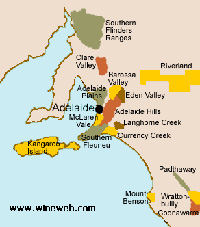 |
Established
in 1984 by brothers Neil and Andrew Pike, Pikes Wines
is a family owned business that now produces about 35,000
cases annually. Located in the Polish Hill River sub
region on the eastern side of the Clare Valley, the
climate here is considerably cooler and the soils are
somewhat unique to the rest of the region - a well-drained
red brown earth (Terra Rosa) over clay with slate and
broken bluestone sub-soil. The 90 acre vineyard was
planted in stages between 1984-1998, with the majority
planted on its own rootstalk with various clones. Also
a small amount of Viognier planted on rootstock. In
winemaking, everything is lightly crushed and destemmed,
natural yeast is used on the whites, with innoculation
on the reds. French barrels are the preferred cooperage.
Pikes also prefers to hold the reds in both barrel and
bottle for 18 months each. Neil likes to point out that
despite his name, "some people think it's a trout"
on the wine label.
Kevin
Mitchell was born and raised in Clare Valley, and has
been a grower for more than 30 years. After stints with
Hardy and Kendall Jackson, in 1997, Kevin purchased
Kilikanoon in the Skillogalee Valley, and produced his
first vintage in 1997. Dry-farmed, the soil is Terra
Rossa (red-brown clay) soil over limestone allowing
excellent drainage and according to Mitchell, nearly
perfect pH. The main vineyards for the Shiraz, Riesling
and Cabernet were all planted 25 years ago in the Leasingham
District of the Clare Valley, where Virtually all of
the wines are dry-farmed and all are picked by hand.
All of the fruit is basket-pressed, before going into
mostly French barrels, along with some American oak.
The inclusion of a Barossa Shiraz led to another little
tidbit - Kevin is apparently working on joint projects
with Rolf Binder, of Veritas-Binder wines.
Impressions:
I'd been a fan of both of these wineries for a long
time - well, at least since the '98 vintage anyway.
The slideshow presentation on the geography and geology
of both properties was enlightening, and both owners
ably articulated the growing conditions of the Clare
Valley. As for the wines - well, tasting these wines
would always be an enjoyable experience, but, tasting
these wines with the winemakers is definitely an unforgettable
experience.
|
The
Wines of Pierre Clavel - Friday, 11:30AM
|
|
DOMAINE
CLAVEL :
2002
Domaine Clavel Vin Blanc Cascaille - Languedoc.
Light buttery citrus in the nose. Very substantial
mouthfeel, with lovely balance, and long lingering
finish. A blend of 3 varieties: Grenache Blanc,
Roussanne, and Rolle (aka Ugni-blanc and Trebbiano).
Spent 10 months in stainless steel.
2004
Domaine Clavel Vin Rose Mescladis - Languedoc.
Fresh, floral and crisp in the nose. Very nice
fleshy mouthfeel, with a nice meaty sensation
on the palate, and a very long crisp finish. Made
in the saignée method. 60% Cinsault.
2003
Domaine Clavel Vin Rouge Le Mas - Languedoc.
Rustic nose of red and black fruit. Very meaty
in mouthfeel and taste, with a nice roasted nut
and meat quality to the long finish. 60% Grenache,
40% Carignan.
2003
Domaine Clavel Vin Rouge Les Garrigues - Languedoc.
Even more than the Le Mas, this wine showed a
roasted meat quality, and the wine picked up a
nice sweet touch toward the finish. 50% Syrah,
30% Grenache, 20% Carignan.
1998
Domaine Clavel Vin Rouge Copa Santa - Languedoc.
Deep cassis-filled nose. Sweet red raspberry on
the palate, excellent balance. Seems predominently
Grenache in texture and taste.
2002
Domaine Clavel Vin Rouge Copa Santa - Languedoc.
Surprising to me, this wine had a very similar
profile to the '98 - that is, seemingly more Grenache
than Syrah. Not sure if I got a double pour of
'98 or what, but the correct blend on this wine
should be 80% Syrah, 10% Grenache, 10% Mourvedre.
2003
Domaine Clavel Vin Rouge Copa Santa - Languedoc.
Huge and fruit-filled, and definitely riper in
the nose as well. Sweet and ripe in mouthfeel,
with a touch of flabbiness at mid-palate, and
anotherwise long finish. (The product of a heat
wave during the vinatge.)
|
(Moderated
byChristophe Baron of Cayuse Vineyards, who also served
as interpreter for Pierre Clavel.)
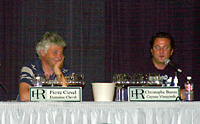 |
| Pierre
Clavel (l), Christophe Baron |
One of the world's oldest winegrowing regions, the Languedoc-Roussillon
is also the largest winegrowing area in the world, extending
from the Rhône to the Pyrenees, with nearly 400,000
acres under vine. And, while the region had once been
known more for the quantity of its wines - rather than
the quality, that situation began to change over the
last few decades. Quality and price are now the mainstays
in the region - thanks in no small part to the winegrowing
of Pierre Clavel.
After leasing land for 6 years, Pierre Clavel established
Domaine Clavel in 1992. Current vineyards total 116
acres in two sites, La Méjanelle and St. Christol.
The 90 acre La Méjanelle Vineyard in on stony,
open ground not too dissimilar to the soil of Châteauneuf-du-Pape.
Subsoils are composed of underlying layers of red-brown
clay and sandstone, but the top soil is covered with
fist-sized round rocks, giving it the appearance of
an ancient riverbed. Current varieties planted include
Grenache Noir, Syrah, Mourvèdre, Carignan, and
Cinsault, and Grenache Blanc, Marsanne, Roussanne, and
Rolle for white wines.
 |
Fermenting
is done in 20,000-50,000 gallon glass-lined concrete
tanks, and the wine left in contact with the skins for
for 25-40 daysof maceration. Minimal new oak is used
during cellar storage for 12-18 months. The La Copa
Santa wines come from lower yields, see smaller tanks
and longer maceration times, and lengthier barrel aging.
The white grapes are lightly pressed along with stems,
fermented separately and then processed together into
the wine. Domaine Clavel produces about 15,000 cases
of red wines, and a mere 300 cases of whites annually.
As
we tasted through the wines, Christophe asked Pierre,
"why not Grenache in the Rose?" Pierre explained
that the 'components were not fixed' in a given wine.
It would depend on 'how he felt about the fruit.' He
would sample the barrels and determine the wine without
concern as to the makeup of the final blend.
It
was interesting to watch Christophe Baron and Pierre
Clavel interact. Aside from their mutual French origins,
they obviously had a great deal of respect for each
other, and it also seemed obvious they enjoyed each
other's company. As the deminar progressed, Christophe
would translate questions from the audience into French,
and re-translate Pierre's French reply back into English.
The two would act almost impish from time to time, as
Christophe would repeat the question in English to Pierre,
who would then reply or otherwise nod, prompting Christophe
to exclaim, "ah, see, you do speak English."
Impressions:
despite having to translate English into French and
vice-versa, I really appreciate this type seminar. There
is always something special about having a winemaker
from France tell you about his wines and winemaking.
But somehow it's even more appreciative when the winemaker
isn't conversant in English. This told me that meant
Pierre Clavel really wanted to be here, and wasn't going
to let language barriers stand in the way.
|
The
Next Generation: the Wines of Linne Calodo and
Pax - Saturday, 9:00AM
|
|
LINNE
CALODO :
2004
Linne Calodo "Contrarian" - Paso Robles.
Lightly sweet tropical fruit, with slightly honeyed
nose. A bit waxy and thick in mouthfeel, with
honeyed spices, touch of pineapple and apricot,
and ling finish. 62% Roussanne, 38% Viognier.
2003
Linne Calodo "Slacker" - Paso Robles.
Mostly blackberry in the nose, but it seems more
hi-toned or punched up than straight Syrah. Big
mouthfeel, quite spicy on the palate, with lots
of dark fruit, and a bit of game. 68% Syrah, 22%
Grenache, 10% Mourvedre.
2003
Linne Calodo "Rising Tides" - Paso Robles.
Nose of blackberry, shoe wax, and a touch of toast.
Nice ripeness on the palate, very spicy and grippy
mouthfeel, huge long finish. 42% Syrah, 37% Grenache,
21% Mourvedre.
2003
Linne Calodo "Nemesis" - Paso Robles.
Nose of blackberry, bittersweet chocolate, mint/camphor,
and toast. Gripping mouthfeel, lots of dark fruit,
huge long finish, with nice bittersweet chocolate
aftertaste. 82% Syrah, 10% Mourvedre, 8% Grenache.
2003
Linne Calodo "Sticks and Stones" - Paso
Robles. Effusive black and red raspberry nose.
Slightly sweet and warm-flavored in the mouth
(not heat from alcohol), lots of grip on the palate,
very nice balance, plenty of sweet/sour dark fruit
throughout, and very long finish. 60% Grenache,
25% Syrah, 15% Mourvedre.
2001
Linne Calodo "Sticks and Stones" - Paso
Robles. Rich and spicy nose - nearly Aussie-like.
Big and chewy mouthfeel, still some grip here,
lots of bittersweet chocolate and dark fruit,
long finish. 60% Grenache, 30% Mourvedre, 10%
Syrah.
PAX:
2004
Pax Viognier "Aphrodite" - Spring Mtn.
Crisp nose of white peach, with just a touch of
nectarine in the nose. Rich feel on the palate,
without being too thick or viscous. (From a section
originally planted by John Kongsgaard.)
2004
Pax Roussanne "Venus" - Sonoma Co.
Minerally and waxy nose, with a honeyed-toast
aroma. Light sweetness on the palate, rich mouthfeel,
very nice balance, honeycomb flavors through the
long finish. Basket pressed.
2003
Pax GSM "Cuvée Moriah" - Sonoma
Co. Big effusive nose of red and black raspberry.
Very full in mouthfeel, spicy raspberry flavors,
very well balanced, and long meltaway finish.
About 70% Grenache, with the balance split between
Syrah and Mourvedre.
2003
Pax Syrah "Castelli-Knight Ranch" -
Russian River Valley. Very dark color - almost
black. Big peppery blackberry nose, with a hint
of iron or iodine. Big mouthfeel, very chewy with
lots of dark fruit and touches of dark chocolate,
spiced blackberry, and a hint of asphalt. Mostly
whole cluster fermentation; 40% new oak.
2003
Pax Syrah "Griffin's Lair" - Sonoma
Coast . Perfumed blackberry and blueberry
in the nose, along with a touch of mineral. Big
roasted and gamey flavors on the palate, slightly
more high-toned in profile, with a seamless long
finish. Mostly whole cluster fermentation.
2003
Pax GSM "Cuvée Keltie" - North
Coast . Killer nose of blackberry pie, with
touches of mint and vanilla. Very gripping on
the palate, obvious dark fruit beneath the slightly
muted flavors, prolonged smooth fine-grained tannic
finish. Usually composed of the best barrels in
the cellar.
2004
Pax Grenache "Bennett Valley Vnyd" -
Sonoma Co. Deep nose of red and black raspberry.
Plenty of tannins on the palate, rich fruit-filled
mouthfeel, very long finish. Probably will go
into the '04 Cuvée Moriah, since Pax doesn't
bottle a Grenache separately (though you never
know). Very little new oak used.
2004
Pax Syrah "Walker Vine Hill" - Russian
River Valley. Nose of velvety blackberry compote.
Sweet and juicy mouthfeel, nice creamy texture,
touches of dark chocolate and pie crust through
the long finish. On Goldridge soil, from a property
near Kistler and Dehlinger.
2004
Pax Syrah "Kobler Family" - Sonoma Co.
Lots of blackberry, touches of blueberry and hints
of floral aromas in nose. Sweet-sour dark fruit
on the palate, very nice acidity, gripping mouthfeel,
and very, very long finish. Biodynamically farmed.
Co-macerated and co-fermented with 10% Viognier
from same vineyard.
2004
Pax Syrah "Alder Springs Vnyd" - Mendocino
Co. Effusive nose of black fruit, with light
meaty and earthy scents. Chewy, with huge tannins,
surprisingly smooth mouthfeel, lots of black fruit,
and a long huge long finish. From 3 separate sections,
vinified separately for the final blend.
|
(Moderated
by John Alban, this seminar gave us a in-depth look
at the wines of Pax Mahle and Linne Calodo's Matt Trevasan.)
 |
| (l
to r) Pax Mahle, Matt Trevisan, and John Alban |
In
his introduction, it was obvious that John Alban very
much admired and respected how much these two winemakers
had achieved in a relative short time.
Matt
commented how he had always told people he'd "never
make a white wine." And yet, contrary to that,
here he was with a white wine. I guess that was really
the whole point of the wine's name - Contrarian.
'Never say never' is probably a good philosophy, since
on my last
visit, I do recall Matt fooling around with
some Rosé juice.
With
Linne Calodo, all of the wines are blends of two or
more varietals, usually Rhône varietals, though
frequently Zinfandel (a Paso Robles staple) is added
to the final blend. Mat selects only westside Paso vineyards
for his fruit, frequently sourcing from Denner, James
Berry, Cherry, Halter, and Lock. Matt is trying to stay
to 6-8 barrel lots (132-176 cases), in order to keep
tight quality control. His production is currently about
1,000 cases, with the intention of increasing this to
3,000 cases over the long term.
Preferring
to use proprietary names for his blends, Matt usually
picks a name that means something to him - something
about the wine's progress or lack thereof. For instance,
he mentioned that his Slacker is made up from
"barrels that don't stand alone," meaning
- using an academic analogy - that while the other wines
were trying to be the best they could be, the barrels
for Slacker were just sloughing off.
Moving
on to pax, I noticed the two whites on the Pax placemat,
which reminded me of a few carboys of opaque white wine
we saw sitting on a palette in the winery during our
last
visit. He was playfully evasive when asked at
the time, but it did appear that he was interested in
making some white wine(s).
Pax
uses indigenous yeasts for all of his fermentations.
With his GSM, he used whole cluster fermentation on
the Grenache, which after pressing was at 17.9%. He
then added Syrah juice to bring the alcohol down. Then,
with the Castelli-Knight and Griffin's Lair, Pax used
50% whole cluster fermentation on half the lot, and
100% whole cluster on the other half, finally blending
the lots back together.
Selecting
vineyards from cooler coastal regions to work with,
Pax makes sure they will allow him to farm the blocks
or rows in some cases to his own needs. When a winemaker
sources fruit from many different locations, I seem
to crave information about these vineyards -- the where
and why. Thenkfully, Pax covered most of the properties,
giving some nice details about each. He talked about
the Castelli-Knight Ranch, and how its north face keep
the vines cooler, and the bright orange iron-rich soils
seem to transfer the same iron/iodine quality to the
palate. He also related how the owners of this Russian
River Valley property had originally wanted to plant
Pinot Noir. We scoffed - well, not really, we actually
felt relieved.
The
Griffin's Lair Syrah comes from a vineyard in the southern
edge of the Sonoma Coast appellation, very near San
Pablo Bay, with a Carneros-like climate. The soil here
is rocky coarse sand, and the windy conditions produce
very small berries (the better to hang-on with, my dear).
Pax's
Grenache source is Bennett Valley Vineyard, located
near Matanzas Creek, and planted to ENTAV clone 513
and Tablas clone. Soils are clay loam and cobbly clay
loam. Given the cooling influences from the Petaluma
Valley, the area is actually cooler than the Sonoma
Valley and has recently applied for its own appellation
as the Bennett Valley AVA. So far, all of the fruit
is intended to go into the Cuvée Moriah, since
a varietal Grenache isn't bottled -- at least not yet.
Walker
Vine Hill in the Russian River Valley is planted in
Goldridge soils in a very cool climate, located behind
Kistler and Dehlinger. Pax had convinced the woman who
owns the property to allow him to farm a "short
row" block on a south-facing portion on the top
of the hill. Finally, Pax farms three 3-acres plots
in well-known Alder Springs Vineyard. Planted in sandstone
soils, it's the altitude - about 2500' that keeps things
cool here.
Two
Pax wines which we didn't taste (I suspect they were
left out in order to add the whites to the program)
were the Syrahs from the Obsidian Vineyard in Knight's
Valley and the Lauterbach Hill Vineyard in the Russian
River Valley. But the representative reds told us all
we need to know - this is good stuff!
John commented on the distinctive image on all the Pax
labels, asking Pax to describe its origin. Pax explained
it was a rendition of a continent known as Pangea
Ultima, relating that, according to scientists,
about 250 million years ago the landmasses of Earth
were clustered into a supercontinent called Pangea.
Apparently, in another 250 million years all seven continentsare
expected to re-form into a single landmass once again,
that of Pangea Ultima. The Pax label is a tribute
to the fact that despite the varying soils and climates,
the vineyards are all from the same piece of land. Finally,
as he seemed to reflect aloud on the idea the the continents
were all moving back toward each other, Pax said: "This
will really piss-off the French when our vineyards are
so close [to theirs]." Got a good laugh on that
one.
Impressions:
one of the most eagerly awaited seminars in the program,
this Linne Calodo/Pax tasting showcased Matt Trevesan's
adept blending of varietals from Paso fruit, and Pax
Mahle's excellent Syrah
winemaking from North Coast-based vineyards.
These two had each been making notable wines since the
start of their enterprises (2000, 2001 respectively),
but as with many others became hot properties once discovered
by the critics (they know their names). The wines were
all impressive, but more than the wines, it was apparent
that both are able to impressively handle the increased
attention and celebrity.
|
The
Wines of Alvaro Palacios - Saturday, 10:30AM
|
|
ALVARO
PALACIOS :
2003
Petalos - Bierzo. Nose of red raspberry and
vanilla, with a light floral quality. Red and
black cherry fruit on the palate, creamy and juicy
mouthfeel, nice mineral taste throughout the long
finish. Sourced from three villages, 60-100 year-old
vines of the Menzia grape. 14-18 months in barrique.
2003
Corullón - Bierzo. Black and blueberry
nose. Sweet-sour blackberry and cherry on the
palate, juicy minerality, hint of iodine, and
lots of fine-grained tannins on the finish. All
from Domaine fruit, 100 separate parcels.
2003
San Martin - Bierzo. Similar profile as the
first two, though higher toned, with more red
fruits. Gripping mouthfeel, seemed slightly more
rustic initially, but depth and complexity appeared
with more time in the glass. Only about 166 cases
made.
2003
Moncerbal - Bierzo. Fascinating nose of black
fruit, Herbs de Provence, sage, and lavender.
Initally rustic mouthfeel gets very juicy at mid-palate,
with excellent balance, and long lightly tannic
finish. Rocky soil. Only about 125 cases made.
2003
Las Lamas - Bierzo. Another fascinating nose
of black and red fruit, along with Herbs de Provence
and floral tones. Red and black fruit on the palate,
very juicy acidity, meaty and rich taste, long
seamless moderately tannic finish. Rocky quartzite
soil.
1998
Las Terrasses - Priorat. Nice ripe nose of
black and red fruit. Juicy raspberry, with a touch
of minerality, and a slightly soft finish. From
vines averaging 25-30 years of age (but some as
old as 60). The blend is primarily Garnacha and
Cariñena, with the balance Cabernet Sauvignon
and possibly Syrah.
2000
Las Terrasses - Priorat. Certainly more gutsy
that the '98, this wine had a dark rich nose and
beautiful balance, juicy acidity, long lingering
finish.
2001
Las Terrasses - Priorat. Slightly sweet nose
and initial mouthfeel. Picks up interesting flavors
of various herbs on the palate and the more red
nose seems to trun toward blacker fruit. Lovely
balance and long finish.
2002
Las Terrasses - Priorat. Gorgeous nose of
black and red fruit, lightly smoked herbs, and
a hint of new leather. Slightly sweet initially
in mouthfeel, the wine develops a beautiful balance
of flavors as well a long very fine-grained tannins
on the long finish.
2000
Finca Dofi - Priorat. Lovely perfumed nose
of fruit, herbs and floral notes. Immediately
delicious, with perfect balance and sweet juicy
fruit, and long seamless finish. Primarily Garnacha,
with about 40% Cabernet Sauvignon, Cariñena,
Syrah and Merlot.
2001
Finca Dofi - Priorat. Lots of black and red
fruit in the nose, with more cassis than the '00.
Smooth textures of red and black fruit, fine dusty
tannins throughout, long smooth finish.
2002
Finca Dofi - Priorat. More toned down than
the '01, with a juicier mouthfeel, fresher (if
softer) nose and flavors.
2001
L'Ermita - Priorat. Nose of predominantly
black fruit, with tuches of toast, herbs, and
light minerality. Smooth, slightly more red fruit
on the palate, beautiful balance, long seamless
finish. Planted in the late '30s, old vine 80%
Grenache and 20% Cabernet Sauvignon. aged in new
French oak for up to 20 months. Usually about
250 cases made per vintage.
2002
L'Ermita - Priorat. Nose of cassis, blackberry,
vanilla and clove. Much softer in mouthfeel than
the '01, al of the flavors are there - just slightly
underfilled. Palacios called this an "anguished
vintage...lacks the concentration" due to
the heat spikes.
2004
L'Ermita - Priorat. Wow! Nose of black and
red fruit, cake spices, clove, and an intriguing
floral tone. Gorgeous balance of red and black
flavors - almost like a berry of its own. Perfect
balance, seamless flavors and textures, long fine-grained
finish.
|
(Moderated
by Debbie Zachareas, Ferry Plaza Wine Merchant &
Bacar, the seminar gave us a closer look at the fantastic
wines of Alvaro Palacios.)
|
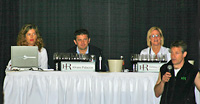
|
| (l
to r) Christine Palacios, Alvaro Palacios, Debbie
Zachareas, and John Alban |
John
Alban introduced the panel and began to describe the
lengths to which he had to go to get Alvaro Palacios
to come to HdR (see above).
After
John Alban's very funny introduction, we got down to
intently listening to someone who has been called a
pioneer, a visionary, and Spain's most important new
winemaker. What is apparent, is that he most certainly
is making the best wine in Spain, if not the world.
Alvaro Palacios was brought up in Rioja, in the family
wine business. After spending 2 years at Château
Pétrus under Jean-Pierre Mouiex, Palacios set
up his own winery in Priorat in 1989. He was drawn to
the unique soil and old vines of Priorat, and decided
he wanted to make a world-class wine - something he
described as a cross between a Pétrus and a Grange.
But it was ultimately the terroir that attracted him
to this area. The Priorat has very little rainfall.
As Palacios likes to say, it has "fresh soil in
a hard climate." Palacios explained that phylloxera
had descimated the Priorat in the early 1900s, so that
there was very little old vine Garnacha left.
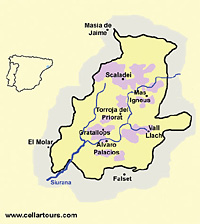 |
|
|
Alvaro
Palacios bought his first vineyard, Finca Dofí,
in 1990, and followed in 1993 with the purchase of an
old vine Garnacha vineyard that had been planted in
the late 1930s - this was to become the L'Ermita Vineyard.
The combined vineyards are about 75 acres. A third wine,
Las Terrasses, is made with fruit specially selected
from other small growers in Priorat. Thought the Romans
usually are given credit for where they did originally
plant grapes, Alvaro tells us that Priorat was not one
of them.
The
L'Ermita vineyard is made of a very coarse-grained easily
broken slated called schist or llicorella.
The hillsides here are also very steep - up to 60 degrees
steep in the case of the L'Ermita vineyard, so the Palacios
vines have to be planted up and down the slope, rather
than traversing it. As Debbie Zachareas put it, "Priorat
makes farming in Germany look easy." The best vines
in Priorat are usually low-yielding old vine Garnacha
or Cariñena (Carignan), but Cabernet Sauvignon,
Merlot and Syrah are also permitted in the blends. Winemaking
methods include separate vinification for each variety.
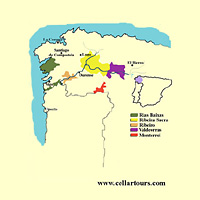 |
|
|
The
fruit for Les Terrasses is sourced from estate grapes
and also from selected lots of purchased Garnacha and
Cariñena grapes from vines averaging 25-30 years
of age (but some as old as 60). The blend is primarily
Garnacha and Cariñena, with the balance Cabernet
Sauvignon and possibly Syrah. The wine is aged for 12
months in 1 to 3-year old mostly French oak. Production
is about 10,000 cases. The blends for Finca Dofi are
from a 16 acre vineyard of primarily Garnacha, with
about 40% Cabernet Sauvignon, Cariñena, Syrah
and Merlot. For L'Ermita, planted in the late '30s,
the wine is 80% old vine Grenache and 20% Cabernet Sauvignon,
aged in new French oak for up to 20 months.
In
1998, Palacios and his nephew Ricardo Perez also begun
making wines from small, old-vine vineyards in another
part of Spain, Bierzo, tucked into northwest part of
the country. Here, the Atlantic, rather than the Mediterrean
plays the role of cooling influence on the native Mencía
grape. Probably a descendant of Roman vines, Mencía
is thought to be an immediate ancestor to Cabernet Franc.
There are about 60 acres of old vine (60-100 yrs old)
Mencía spread over two separate sites and 128
different blocks.
Impressions:
well, this seminar was a fantastic finish to the program.
While his wife ran a slide show from her laptop, an
articulate Alvaro Palacios went into a thorough description
of both Priorat and Bierzo, and took us through the
marvelous flights of wines he brought, including three
of the cult status L'Ermita bottlings.
2005
HdR : Intro | the
Tastings | the Auction Lots
| Photo
Journal
|
